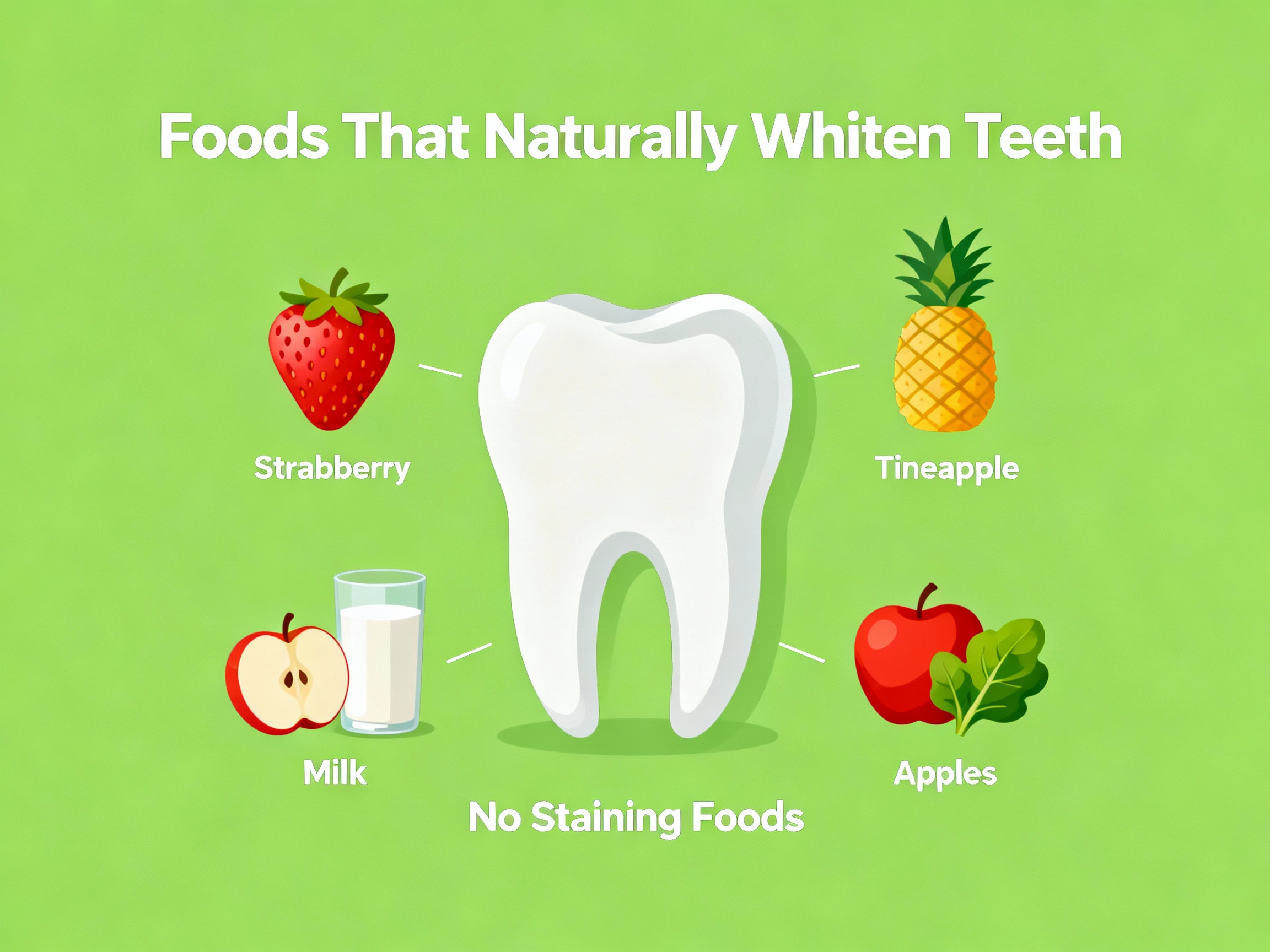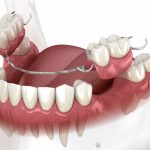Your smile is one of the first things people notice about you. But did you know that what you eat and drink every day can either brighten or dull your teeth? Certain foods contain natural compounds that help polish away stains or strengthen enamel. Others leave behind pigments that gradually darken your smile.
Let’s explore the foods and drinks that naturally whiten teeth and those that cause discoloration. Also, explore some safe, natural ways to keep your teeth bright at home.
Table of Contents
Toggle5 Foods That Naturally Whiten Teeth
Some foods can act as natural cleansers for your teeth. They contain mild acids, enzymes, or fibrous textures that help scrub away stains while supporting overall oral health.
1. Strawberries
Strawberries are more than just a sweet snack; they’re rich in malic acid, a natural substance that may help remove surface discoloration. When eaten regularly, the fruit can gently polish teeth and enhance brightness.
But do strawberries whiten teeth? Healthline notes that, while results vary, strawberries’ mild bleaching effect is due to their malic acid content, which is similar to that found in some whitening toothpastes.
2. Watermelon
Watermelon contains even more malic acid than strawberries. Its high water content also helps wash away food particles and bacteria. Though scientific evidence is limited, it’s considered a tooth-friendly fruit that supports natural cleaning through hydration and light acidity.
3. Pineapple
Pineapple contains bromelain, an enzyme that breaks down the thin film of proteins that forms on teeth after eating, known as the pellicle layer. By disrupting this film, bromelain helps prevent stain buildup and maintains enamel brightness.
4. Papaya
Similar to pineapple, papaya contains papain, a natural enzyme that dissolves proteins that cling to tooth enamel. Regular use may help prevent the accumulation of surface stains and contribute to a healthier, whiter smile.
5. Milk
Wondering, does milk whiten teeth? Yes, to some degree. Milk and other dairy products contain lactic acid and casein, two compounds that support enamel health. Casein can bind to tannins, the compounds found in coffee and tea that cause stains, reducing their ability to discolor teeth. Dairy also helps neutralize acids in the mouth, maintaining a healthy pH balance that protects enamel.
Drinks That Help Whiten Teeth Naturally
Drinks can also help brighten your smile, especially those that clean, hydrate, or neutralize acidity.
Water
Water is the simplest and most effective natural cleanser. Sipping or swishing water throughout the day helps remove food particles, pigments, and bacteria. It also promotes saliva production, which is your body’s natural defense against staining and decay.
Coconut Water
Coconut water’s antioxidants and hydrating properties may indirectly support a whiter smile. While it doesn’t bleach teeth, it reduces bacterial buildup that can dull enamel.
Herbal Tea
Unlike black tea, certain herbal teas, such as chamomile or peppermint, are low in tannins. They help maintain a clean mouth environment without contributing to discoloration.
Dairy-Based Smoothies
Blending milk or yogurt with mild fruits like bananas or papaya can give you a tooth-friendly drink that supports enamel strength and gentle whitening.
5 Foods That Stain Teeth
Some of your favorite foods may be the reason your teeth look less bright over time. These contain pigments known as chromogens and compounds called tannins, both of which cling to enamel. Acidic foods also make enamel more porous, allowing stains to set in. Here are 5 teeth discoloration foods:
1. Berries
Blueberries, blackberries, and pomegranates are rich in antioxidants, but their dark pigments can easily stain enamel. Even berry-based juices can leave lasting discoloration.
2. Tomato Sauce
Tomatoes are healthy, but their acidity, combined with their rich red color, can dull your smile. Pairing tomato-based dishes with crunchy vegetables, or rinsing them afterward, helps minimize staining.
3. Curry
Bright yellow spices like turmeric in curry dishes can stain teeth with regular consumption. The strong pigments cling to enamel, leaving a yellow hue over time.
4. Soy Sauce
Dark sauces like soy sauce are deeply pigmented. Their color binds easily to enamel, especially when teeth are porous from acid exposure.
5. Beetroot
Beetroot’s intense red pigments can stain everything from your hands to your teeth. Its staining power is so strong that even brief contact can leave a tint behind.
5 Drinks That Stain Teeth
Many beverages contribute to teeth discoloration due to their acidity, tannins, and dark coloring. Here are the most common culprits according to Healthline.
1. Coffee
Coffee is one of the most frequent causes of yellowish stains. It’s acidic and full of tannins that latch onto enamel. Regular drinkers often notice surface stains, especially when oral hygiene is poor.
2. Tea
Black tea can be even worse than coffee for staining, as it contains higher levels of tannins. Green tea may leave a dull grayish hue. If you love tea, adding a little milk can reduce staining by binding tannins.
3. Red Wine
Red wine combines acidity, chromogens, and tannins, a perfect trio for stains. It slightly erodes enamel, allowing pigments to settle deeper.
4. Dark Sodas
Colas and dark soft drinks contain caramel coloring and acids that both discolor and weaken enamel. The sugar content also encourages bacterial growth, worsening dullness.
5. Fruit Juices
Dark juices like grape, cranberry, and pomegranate are high in chromogens. They can stain enamel, especially when consumed frequently or sipped slowly.
Natural Ways to Whiten Teeth at Home
Professional whitening treatments offer quick results, but natural methods can help maintain brightness safely between dental visits. The following natural teeth whitening remedies are evidence-based and mentioned by Healthline and Medical News Today:
1. Oil Pulling
Swishing coconut or sesame oil around your mouth for 10–15 minutes can remove bacteria and plaque buildup. While it doesn’t bleach teeth, it helps maintain cleanliness and reduce yellowing over time.
2. Baking Soda
Baking soda is a gentle abrasive that helps remove surface stains. Brushing with a paste made of baking soda and water a few times a week can polish teeth. Notes that this method brightens teeth without damaging enamel when used in moderation.
3. Hydrogen Peroxide
Hydrogen peroxide is a mild bleaching agent found in many whitening products. Using a diluted solution (equal parts peroxide and water) as a mouth rinse can lighten surface stains. Overuse, however, may irritate gums, so it should be used sparingly.
4. Fruit Peels
Medical News Today mentions rubbing the inner side of a banana or orange peel on teeth as a natural remedy. The minerals in the peels may contribute to mild surface cleaning, though evidence is limited.
5. Activated Charcoal
Activated charcoal can absorb surface stains, but experts caution that it can be abrasive. It should be used gently and infrequently.
6. Limit Staining Foods and Drinks
One of the simplest whitening methods is prevention. Reducing tea, coffee, or wine intake or rinsing immediately afterward prevents pigments from settling. Using a straw for dark beverages also minimizes contact with teeth.
7. Maintain Oral Hygiene
Regular brushing and flossing are the foundation of natural teeth whitening. Removing plaque and preventing tartar buildup keeps your teeth naturally lighter.
Lincolnwood Family Dental: Your Trusted Family Dentist in Lincolnwood, IL
At Lincolnwood Family Dental, your comfort is at the heart of everything we do. As a women-led, family-run dental clinic serving the Lincolnwood community since 2021, we take pride in offering gentle, personalized care for every age and smile.
Whether you need Invisalign, dentures, kids dentistry, dental implants, or emergency dental care, our experienced team is here to help you achieve a healthy, confident smile. We also specialize in cosmetic, general, and preventive dentistry, ensuring your oral health stays strong for years to come.
We’re proud to be in-network with all major PPO providers, including Aetna, Blue Cross Blue Shield, Cigna, Delta Dental, MetLife, Guardian, Humana, Principal, and United Healthcare. Our team takes the time to help you understand and maximize your insurance benefits, because quality care should always be accessible and stress-free.
Conclusion
Natural whitening doesn’t require harsh chemicals or expensive treatments. Simple dietary choices can make a visible difference over time. On the other hand, coffee, tea, and dark-colored sauces can undo that brightness if not balanced properly. Rinse often, maintain good hygiene, and schedule regular dental checkups for professional deep cleaning. A brighter smile comes from daily habits, not just quick fixes.
Frequently Asked Questions
Does milk whiten teeth?
Yes. Milk contains lactic acid and casein, which help strengthen enamel and reduce staining by binding to tannins. Regular milk consumption supports a healthy, naturally brighter smile.
Do strawberries whiten teeth?
Strawberries contain malic acid, a natural compound that may lighten surface stains. While not a substitute for professional whitening, they can complement your routine.
What foods whiten teeth the fastest?
Fruits like strawberries, pineapple, and papaya contain natural enzymes that act quickly on surface stains. However, whitening through food is gradual and requires consistency.
What fruit whitens teeth?
According to Healthline, strawberries, pineapple, papaya, and watermelon are the top fruits that may help whiten teeth naturally.
Is natural teeth whitening safe for enamel?
When done correctly, yes. Using gentle abrasives, such as baking soda or diluted hydrogen peroxide, occasionally is safe. Overuse of acids or harsh scrubs, however, can erode enamel.









